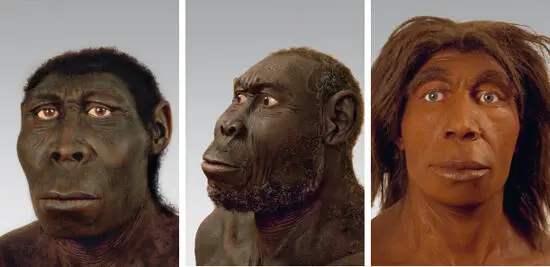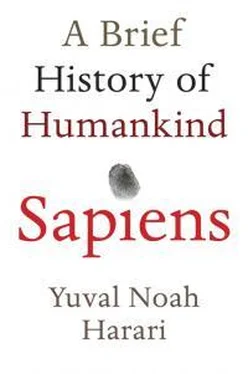Skeletons in the Closet
Homo sapiens has kept hidden an even more disturbing secret. Not only do we possess an abundance of uncivilised cousins, once upon a time we had quite a few brothers and sisters as well. We are used to thinking about ourselves as the only humans, because for the last 10,000 years, our species has indeed been the only human species around. Yet the real meaning of the word human is ‘an animal belonging to the genus Homo ’, and there used to be many other species of this genus besides Homo sapiens . Moreover, as we shall see in the last chapter of the book, in the not so distant future we might again have to contend with non -sapiens humans. To clarify this point, I will often use the term ‘Sapiens’ to denote members of the species Homo sapiens , while reserving the term ‘human’ to refer to all extant members of the genus Homo .
Humans first evolved in East Africa about 2.5 million years ago from an earlier genus of apes called Australopithecus , which means ‘Southern Ape’. About 2 million years ago, some of these archaic men and women left their homeland to journey through and settle vast areas of North Africa, Europe and Asia. Since survival in the snowy forests of northern Europe required different traits than those needed to stay alive in Indonesia’s steaming jungles, human populations evolved in different directions. The result was several distinct species, to each of which scientists have assigned a pompous Latin name.

2. Our siblings, according to speculative reconstructions (left to right):
Homo rudolfensis (East Africa); Homo erectus (East Asia); and Homo neanderthalensis (Europe and western Asia). All are humans.
Humans in Europe and western Asia evolved into Homo neanderthalensis (‘Man from the Neander Valley), popularly referred to simply as ‘Neanderthals’. Neanderthals, bulkier and more muscular than us Sapiens, were well adapted to the cold climate of Ice Age western Eurasia. The more eastern regions of Asia were populated by Homo erectus , ‘Upright Man’, who survived there for close to 2 million years, making it the most durable human species ever. This record is unlikely to be broken even by our own species. It is doubtful whether Homo sapiens will still be around a thousand years from now, so 2 million years is really out of our league.
On the island of Java, in Indonesia, lived Homo soloensis , ‘Man from the Solo Valley’, who was suited to life in the tropics. On another Indonesian island – the small island of Flores – archaic humans underwent a process of dwarfing. Humans first reached Flores when the sea level was exceptionally low, and the island was easily accessible from the mainland. When the seas rose again, some people were trapped on the island, which was poor in resources. Big people, who need a lot of food, died first. Smaller fellows survived much better. Over the generations, the people of Flores became dwarves. This unique species, known by scientists as Homo floresiensis , reached a maximum height of only one metre and weighed no more than twenty-five kilograms. They were nevertheless able to produce stone tools, and even managed occasionally to hunt down some of the island’s elephants – though, to be fair, the elephants were a dwarf species as well.
In 2010 another lost sibling was rescued from oblivion, when scientists excavating the Denisova Cave in Siberia discovered a fossilised finger bone. Genetic analysis proved that the finger belonged to a previously unknown human species, which was named Homo denisova . Who knows how many lost relatives of ours are waiting to be discovered in other caves, on other islands, and in other climes.
While these humans were evolving in Europe and Asia, evolution in East Africa did not stop. The cradle of humanity continued to nurture numerous new species, such as Homo rudolfensis , ‘Man from Lake Rudolf’, Homo ergaster , ‘Working Man’, and eventually our own species, which we’ve immodestly named Homo sapiens , ‘Wise Man’.
The members of some of these species were massive and others were dwarves. Some were fearsome hunters and others meek plant-gatherers. Some lived only on a single island, while many roamed over continents. But all of them belonged to the genus Homo . They were all human beings.
It’s a common fallacy to envision these species as arranged in a straight line of descent, with Ergaster begetting Erectus, Erectus begetting the Neanderthals, and the Neanderthals evolving into us. This linear model gives the mistaken impression that at any particular moment only one type of human inhabited the earth, and that all earlier species were merely older models of ourselves. The truth is that from about 2 million years ago until around 10,000 years ago, the world was home, at one and the same time, to several human species. And why not? Today there are many species of foxes, bears and pigs. The earth of a hundred millennia ago was walked by at least six different species of man. It’s our current exclusivity, not that multi-species past, that is peculiar – and perhaps incriminating. As we will shortly see, we Sapiens have good reasons to repress the memory of our siblings.
The Cost of Thinking
Despite their many differences, all human species share several defining characteristics. Most notably, humans have extraordinarily large brains compared to other animals. Mammals weighing sixty kilograms have an average brain size of 200 cubic centimetres. The earliest men and women, 2.5 million years ago, had brains of about 600 cubic centimetres. Modern Sapiens sport a brain averaging 1,200–1,400 cubic centimetres. Neanderthal brains were even bigger.
That evolution should select for larger brains may seem to us like, well, a no-brainer. We are so enamoured of our high intelligence that we assume that when it comes to cerebral power, more must be better. But if that were the case, the feline family would also have produced cats who could do calculus. Why is genus Homo the only one in the entire animal kingdom to have come up with such massive thinking machines?
The fact is that a jumbo brain is a jumbo drain on the body. It’s not easy to carry around, especially when encased inside a massive skull. It’s even harder to fuel. In Homo sapiens , the brain accounts for about 2–3 per cent of total body weight, but it consumes 25 per cent of the body’s energy when the body is at rest. By comparison, the brains of other apes require only 8 per cent of rest-time energy. Archaic humans paid for their large brains in two ways. Firstly, they spent more time in search of food. Secondly, their muscles atrophied. Like a government diverting money from defence to education, humans diverted energy from biceps to neurons. It’s hardly a foregone conclusion that this is a good strategy for survival on the savannah. A chimpanzee can’t win an argument with a Homo sapiens , but the ape can rip the man apart like a rag doll.
Today our big brains pay off nicely, because we can produce cars and guns that enable us to move much faster than chimps, and shoot them from a safe distance instead of wrestling. But cars and guns are a recent phenomenon. For more than 2 million years, human neural networks kept growing and growing, but apart from some flint knives and pointed sticks, humans had precious little to show for it. What then drove forward the evolution of the massive human brain during those 2 million years? Frankly, we don’t know.
Читать дальше




![Юваль Ной Харари - Sapiens. Краткая история человечества [litres]](/books/34310/yuval-noj-harari-sapiens-kratkaya-istoriya-cheloveche-thumb.webp)





![Юваль Ной Харари - 21 урок для XXI века [Версия с комментированными отличиями перевода]](/books/412481/yuval-noj-harari-21-urok-dlya-xxi-veka-versiya-s-ko-thumb.webp)


